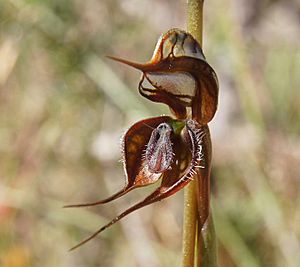Large rustyhood facts for kids
Quick facts for kids Large rustyhood |
|
|---|---|
 |
|
| Scientific classification | |
| Genus: |
Pterostylis
|
| Species: |
maxima
|
| Synonyms | |
|
Oligochaetochilus maximus (D.L.Jones & M.A.Clem.) Szlach. |
|
The Large Rustyhood (scientific name: Pterostylis maxima) is a special kind of plant. It belongs to the amazing orchid family. You can only find this orchid in south-eastern Australia. It's like a unique treasure of that region! This plant has a group of leaves shaped like a circle at its bottom, called a rosette. It can grow up to eight fairly big, dark brown flowers. These flowers even have clear "windows" and a thin, dark part that looks like an insect. This part is called the labellum.
Contents
What the Large Rustyhood Looks Like
The Pterostylis maxima is a plant that grows on the ground. It's a perennial plant, meaning it lives for more than two years. It's also a deciduous herb, which means its leaves fall off each year. This plant grows from a special underground part called a tuber.
At the bottom of its flowering stem, it has a rosette of leaves. There are usually six to twelve of these egg-shaped leaves. Each leaf is about 15 to 45 mm (0.6 to 1.8 in) long. They are also about 10 to 18 mm (0.4 to 0.7 in) wide.
The plant grows a tall flowering stem, which can be 200 to 350 mm (7.9 to 14 in) tall. On this stem, you'll find between two and eight dark reddish-brown flowers. Each flower has clear, see-through parts. The flowers are quite large, about 35 to 60 mm (1.4 to 2.4 in) long. They are also about 12 to 14 mm (0.5 to 0.6 in) wide. There are also four to six leaves wrapped around the flowering stem.
The top part of the flower, called the dorsal sepal, joins with the petals. Together, they form a hood over the flower's center. This hood is called the "galea." The dorsal sepal has a thin, thread-like tip that is 7 to 12 mm (0.3 to 0.5 in) long.
The side parts of the flower, called the lateral sepals, are wider than the galea. They are shaped like a dish and have lots of tiny hairs on their outer edges. These sepals suddenly narrow into thread-like tips. These tips are 25 to 35 mm (1.0 to 1.4 in) long and grow parallel to each other.
The most interesting part is the labellum. It's reddish-brown, thin, and looks like an insect! It's about 6 to 8 mm (0.2 to 0.3 in) long and 4 mm (0.2 in) wide. The "head" end of the labellum is swollen and has two long bristles. There are also 8 to 12 shorter bristles on each side of the "body" part. This orchid usually blooms from October to November.
How the Large Rustyhood Got its Name
The Pterostylis maxima was first officially described in 1989. Two botanists, David Jones and Mark Clements, described it. They found a sample of the plant near Bendigo. Their description was then published in a science book called Australian Orchid Research.
The second part of its scientific name, maxima, comes from a Latin word. It means "greatest" or "largest." This name was chosen because of the orchid's relatively large size.
Where the Large Rustyhood Lives
The Large Rustyhood orchid grows in different places across south-eastern Australia. You can find it in scattered groups. It grows south from a town called Temora in New South Wales. It also grows all across Victoria. And you can find it in the south-east part of South Australia.
This orchid likes to grow in different types of natural areas. It lives in woodlands, open forests, and areas with mallee trees.
Protecting the Large Rustyhood
Sadly, the Pterostylis maxima is a plant that needs our help. In Victoria, it is considered "vulnerable." This means it could become endangered if we don't protect it. In South Australia, it is even more at risk. There, it is listed as "endangered," meaning it faces a very high risk of disappearing from the wild. Efforts are being made to protect this unique Australian orchid.

